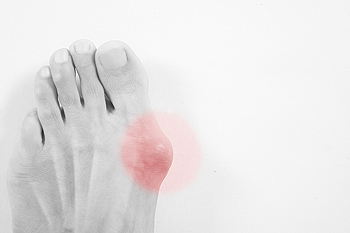
 First and foremost, a bunion is a deformity of the big toe. Typically, it’s a bony protrusion that forms on the side of the big toe. Less commonly, a bunion may form next to the small toe, also known as a “bunionette.” There are many causes for bunions. Tight shoes, especially shoes with a narrow toe box, (ex: cowboy boots and high heels) are the culprits of bunions in most patients. Genetics often play a significant role as well. Experts believe that certain foot types make a person more prone to developing bunions, and these foot types tend to run in families. One study found that 83 percent of people who have bunions have a family history of bunions. It is also said that people who have rheumatoid arthritis and neuromuscular conditions are more prone to bunions. If you feel you have a bunion or you are experiencing soreness, redness, stiffness, and/or swelling around the big toe joint, it is best to consult with your local podiatrist.
First and foremost, a bunion is a deformity of the big toe. Typically, it’s a bony protrusion that forms on the side of the big toe. Less commonly, a bunion may form next to the small toe, also known as a “bunionette.” There are many causes for bunions. Tight shoes, especially shoes with a narrow toe box, (ex: cowboy boots and high heels) are the culprits of bunions in most patients. Genetics often play a significant role as well. Experts believe that certain foot types make a person more prone to developing bunions, and these foot types tend to run in families. One study found that 83 percent of people who have bunions have a family history of bunions. It is also said that people who have rheumatoid arthritis and neuromuscular conditions are more prone to bunions. If you feel you have a bunion or you are experiencing soreness, redness, stiffness, and/or swelling around the big toe joint, it is best to consult with your local podiatrist.
If you are suffering from bunions, contact Dr. Thomas Tran of Southwestern Foot & Ankle Associates, P.C.. Our doctor can provide the care you need to keep you pain-free and on your feet.
What Is a Bunion?
A bunion is formed of swollen tissue or an enlargement of boney growth, usually located at the base joint of the toe that connects to the foot. The swelling occurs due to the bones in the big toe shifting inward, which impacts the other toes of the foot. This causes the area around the base of the big toe to become inflamed and painful.
Why Do Bunions Form?
Genetics – Susceptibility to bunions are often hereditary
Stress on the feet – Poorly fitted and uncomfortable footwear that places stress on feet, such as heels, can worsen existing bunions
How Are Bunions Diagnosed?
Doctors often perform two tests – blood tests and x-rays – when trying to diagnose bunions, especially in the early stages of development. Blood tests help determine if the foot pain is being caused by something else, such as arthritis, while x-rays provide a clear picture of your bone structure to your doctor.
How Are Bunions Treated?
If you have any questions, please feel free to contact our office located in Frisco, TX . We offer the newest diagnostic and treatment technologies for all your foot care needs.
Read more about What Are Bunions?Copyright © Southwestern Foot and Ankle Associates, P.C. | Site Map | Nondiscimination | Design by: Podiatry Content Connection